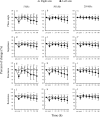Bioimpedance analysis for identifying new indicators of exercise-induced muscle damage
- PMID: 38961243
- PMCID: PMC11222495
- DOI: 10.1038/s41598-024-66089-8
Bioimpedance analysis for identifying new indicators of exercise-induced muscle damage
Abstract
A noninvasive, immediate, and convenient method for assessing muscle tissue status during exercise-induced muscle damage (EIMD) has not been established. This study was designed to assess and determine parameters suitable for measuring EIMD after eccentric exercise, using multi-frequency bioimpedance analysis (BIA). Thirty-five young male participants performed dumbbell exercises with their left arm, and their BIA parameters were measured at various time points up to 168 h post exercise using a multi-frequency BIA device. At all-time points, intra and extracellular water content was greater in the left arm than in the right arm, whereas the impedance, reactance, resistance, and phase angle were lower in the left arm than in the right arm. Established EIMD indices, such as maximal isometric voluntary contraction, were measured and used in correlational analyses. Only reactance was correlated with biomarkers, indicating muscle damage (r = - 0.56 to - 0.49). Furthermore, reactance was found to correlate well with indirect indicators of EIMD, suggesting that it may be a suitable marker for evaluating EIMD. However, the relationship with the limited evaluation indices employed in this study is constrained. Future studies should investigate the correlation between reactance and direct damage indicators, such as structural damage, observed in biopsies.
Keywords: Bioimpedance analysis; Biomarker; Correlation analysis; Eccentric exercise; Exercise-induced muscle damage; Reactance.
© 2024. The Author(s).
Conflict of interest statement
The authors declare no competing interests.
Figures





References
-
- Kanda K, et al. Eccentric exercise-induced delayed-onset muscle soreness and changes in markers of muscle damage and inflammation. Exerc. Immunol. Rev. 2013;19:72–85. - PubMed
MeSH terms
LinkOut - more resources
Full Text Sources
Medical

